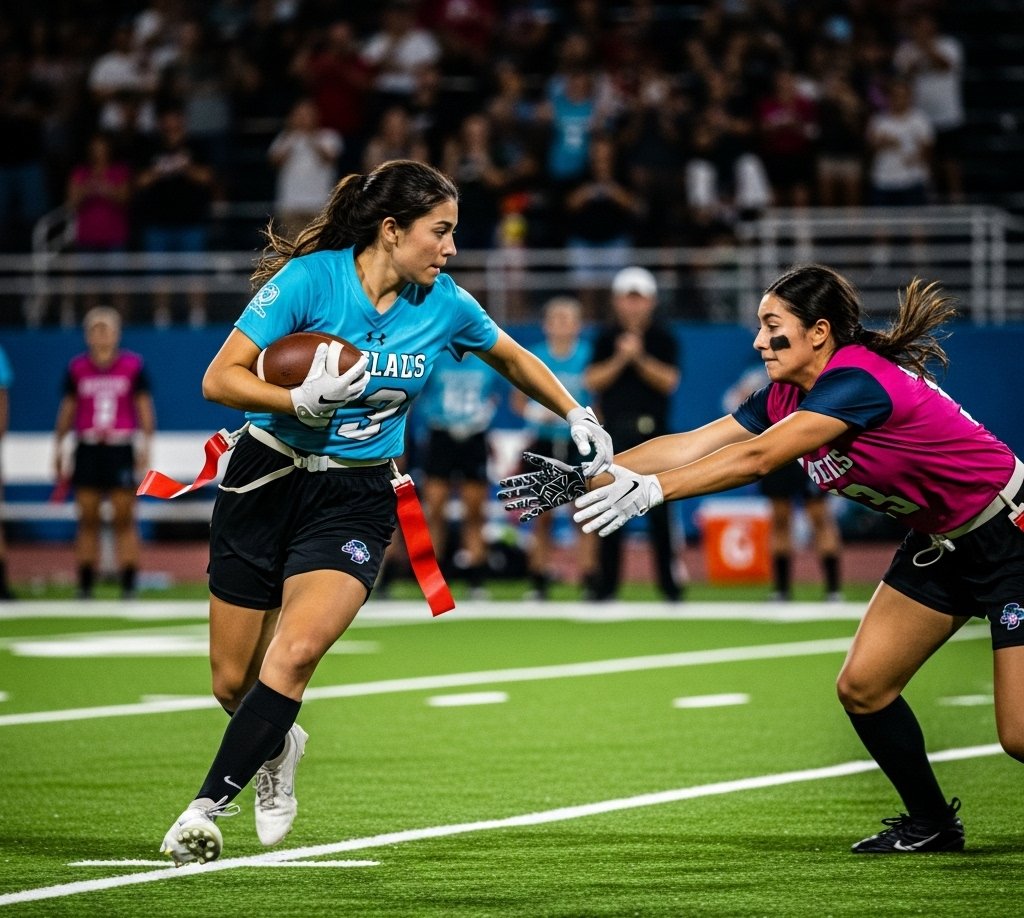Introduction
Over the past decade, women’s flag football has emerged as one of the fastest-growing sports in the United States and worldwide. Once viewed as a casual recreation, it is now recognized as a competitive, organized, and highly skilled sport with opportunities ranging from high school programs to college scholarships and even professional leagues.
Unlike tackle football, flag football provides a safer alternative while still delivering the excitement, strategy, and athleticism that fans love. Because of this, more schools, universities, and organizations are embracing it as a pathway for women athletes to excel in a traditionally male-dominated sport.
In this comprehensive guide, we’ll explore the history, rules, benefits, college opportunities, and future of women’s flag football. Whether you’re a player, coach, or fan, this article will give you everything you need to know about the sport’s growing influence.
The Rise of Women’s Flag Football
Flag football has been played for decades, but the growth of women’s flag football is a relatively recent phenomenon. The movement gained traction when the National Association of Intercollegiate Athletics (NAIA) and the National Football League (NFL) partnered in 2020 to establish women’s flag football as a sanctioned collegiate sport.
Since then, the number of high school and college programs offering the sport has exploded. In 2021, only a handful of schools had teams. By 2025, hundreds of schools across the country either sponsor flag football programs or are considering adding them.
This rapid expansion reflects both increased demand and broader recognition of women athletes. As a result, flag football is now considered one of the most accessible entry points into competitive sports for women.
Why Women’s Flag Football Matters
The rise of women’s flag football carries deep significance. First, it provides athletic opportunities for women who might not pursue traditional sports like basketball or soccer. Second, it promotes gender equity in athletics, aligning with the goals of Title IX by expanding options for female athletes.
Most importantly, the sport changes cultural perceptions. Football has historically been male-dominated, but women’s flag football proves that athletic ability, strategic thinking, and leadership are not limited by gender. Because of this, young girls now see a future in a sport that was once closed off to them.
Basic Rules of Women’s Flag Football
Although similar to tackle football, flag football has its own set of rules designed for safety and speed.
Team Size: Most games are played 5-on-5 or 7-on-7.
Field Dimensions: Smaller than a traditional football field, often 80 yards by 40 yards.
Game Duration: Two halves, usually 20–25 minutes each, with a running clock.
No Tackling: Players wear flags on their hips. To stop a ball carrier, defenders pull the flag instead of making contact.
Downs: Teams typically have four downs to advance the ball 20 yards.
Scoring: Touchdowns are worth six points, with conversion attempts worth one or two points depending on distance.
These rules keep the sport fast-paced and high scoring while reducing injury risks.
Skills Required in Women’s Flag Football
Despite being non-contact, women’s flag football requires a unique blend of athletic skills.
Speed and Agility: Quick movements help players evade defenders.
Throwing Accuracy: Quarterbacks must deliver precise passes.
Catching Ability: Wide receivers need strong hands and sharp routes.
Defensive Instincts: Pulling flags demands excellent timing and positioning.
Teamwork and Strategy: Communication is essential for both offense and defense.
Because of these requirements, flag football not only builds athleticism but also develops leadership and critical thinking.
Women’s Flag Football at the High School Level
High schools across the country are rapidly adopting women’s flag football programs. States such as Florida, Georgia, and Nevada have already sanctioned the sport at the varsity level, with others following close behind.
High school participation matters because it provides exposure and training opportunities that prepare athletes for college-level play. For many young women, these programs represent the first step toward competing on a larger stage.
In addition, flag football at the high school level fosters community spirit. Games attract large crowds, rivalries form, and players gain recognition in the same way athletes from other traditional sports do.
Women’s Flag Football in College
Perhaps the most exciting development in the sport’s growth is the introduction of collegiate women’s flag football.
The NAIA officially recognized it as a sport in 2020.
Dozens of colleges now offer varsity-level programs.
Scholarships are increasingly available, making the sport financially accessible.
Collegiate programs not only elevate the competition but also provide visibility that attracts younger athletes to the sport. Because of this, women’s flag football is expected to become an NCAA-sanctioned sport in the near future.
Professional and International Opportunities
While still developing, professional women’s flag football is gaining momentum. Leagues in the U.S. are emerging, supported by organizations like the NFL Flag Football program. Additionally, women’s flag football has been included in major events like The World Games.
Perhaps the biggest breakthrough came in 2022, when the International Olympic Committee (IOC) confirmed that flag football will be included in the 2028 Los Angeles Olympics. This means women athletes will soon compete for Olympic gold in a sport that was once considered a backyard game.
Health and Social Benefits of Playing
Participation in women’s flag football offers numerous benefits:
Physical Health → Improves cardiovascular fitness, agility, and endurance.
Mental Strength → Builds resilience, confidence, and leadership.
Community → Encourages teamwork, friendships, and school spirit.
Opportunity → Opens doors to scholarships, recognition, and career pathways in sports.
Unlike tackle football, flag football reduces injury risks, making it more accessible to a wider range of athletes.
Challenges Facing Women’s Flag Football
Although the sport is growing quickly, challenges remain.
Limited Resources: Many schools lack funding or facilities.
Cultural Perceptions: Some communities still view football as “a boys’ sport.”
Media Coverage: Women’s flag football receives far less attention compared to other sports.
Overcoming these barriers requires continued investment, advocacy, and media promotion.
The Future of Women’s Flag Football
The future looks incredibly bright. With high school and college programs expanding, professional leagues gaining traction, and the Olympic debut on the horizon, women’s flag football is on the verge of a breakthrough.
Experts predict that by 2030, women’s flag football will be one of the top five female team sports in the U.S., rivaling soccer and basketball in participation numbers. Internationally, the sport will also grow as countries prepare for Olympic competition.
Conclusion
Women’s flag football is more than just a sport—it’s a movement. It represents athletic opportunity, gender equity, and community pride. From high school fields to the Olympic stage, women are proving that football belongs to everyone.
As the sport continues to expand, now is the perfect time for athletes, schools, and fans to get involved. Whether you’re a player chasing a scholarship, a coach building a program, or a fan cheering from the stands, women’s flag football has a place for you.
The future is bright, and the journey is only beginning.

